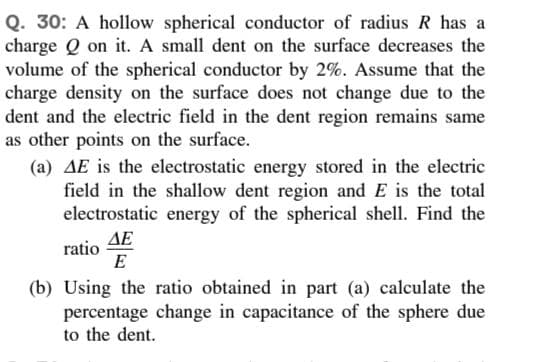Q. 30: A hollow spherical conductor of radius R has a charge Q on it. A small dent on the surface decreases the volume of the spherical conductor by 2%. Assume that the charge density on the surface does not change due to the dent and the electric field in the dent region remains same as other points on the surface. (a) AE is the electrostatic energy stored in the electric field in the shallow dent region and E is the total electrostatic energy of the spherical shell. Find the ΔΕ ratio E (b) Using the ratio obtained in part (a) calculate the percentage change in capacitance of the sphere due to the dent.
Q. 30: A hollow spherical conductor of radius R has a charge Q on it. A small dent on the surface decreases the volume of the spherical conductor by 2%. Assume that the charge density on the surface does not change due to the dent and the electric field in the dent region remains same as other points on the surface. (a) AE is the electrostatic energy stored in the electric field in the shallow dent region and E is the total electrostatic energy of the spherical shell. Find the ΔΕ ratio E (b) Using the ratio obtained in part (a) calculate the percentage change in capacitance of the sphere due to the dent.
Related questions
Question

Transcribed Image Text:Q. 30: A hollow spherical conductor of radius R has a
charge Q on it. A small dent on the surface decreases the
volume of the spherical conductor by 2%. Assume that the
charge density on the surface does not change due to the
dent and the electric field in the dent region remains same
as other points on the surface.
(a) AE is the electrostatic energy stored in the electric
field in the shallow dent region and E is the total
electrostatic energy of the spherical shell. Find the
ΔΕ
ratio
E
(b) Using the ratio obtained in part (a) calculate the
percentage change in capacitance of the sphere due
to the dent.
Expert Solution
This question has been solved!
Explore an expertly crafted, step-by-step solution for a thorough understanding of key concepts.
Step by step
Solved in 4 steps
